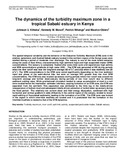The Dynamics Of The Turbidity Maximum Zone In A Tropical Sabaki Estuary In Kenya.

View/
Date
2014-05Author
Kitheka, Johnson U.
Mavuti, Kennedy M
Nthenge, Patrick
Obiero, Maurice
Language
enMetadata
Show full item recordAbstract
The spatial temporal variability and the behavio r of the Estuarine Turbidity Maximum (ETM) zone in the
shallow, ephemeral, well
-
flushed Sabaki estuary located in the northern region of the Kenya coast, were
studied during a period of moderate river discharge. The estuary is one of the most turbid estuaries along the coast of East Africa, characterized by high sediment input and high suspended matter (SPM)
concentrations. The estuary is completely flushed after every tidal cycle and experiences high salinity
and SPM concentrations gradients at high water
(HW). The ETM was generated at HW during periods
when the river runoff was near the long-term average (63 m3s-1) and also when it was relatively low (35m3s-1). The SPM concentrations in the ETM zone varied significantly depending on the river sediment
i
nput and phase of the semi
-
diurnal tide, but were on average 50% greater than the river SPM
concentrations. The ETM was also located up
-
estuary during periods when river runoff was around the
long-term average and further down
-
estuary during periods of low
river runoff, due to different
sediment settling rates. While gravitational circulation tended to cause accumulation of mud in a null
zone located below the freshwater-saltwater interface, causing formation of an ETM zone, the ETM was
separated from the
salt
-
limit. This separation was attributed to the time lag in the tidally
-
driven
resuspension of bottom mud and subsequent tidally
-
driven advection of turbid water up
-
estuary during
the flood period. The relatively low current shear and tidal energy dissipation, combined with high
horizontal and vertical gradient in eddy diffusivity in the central region of the estuary, tended to
favour
rapid settling of flocculated sediments, leading to the formation of an ETM. The ETM zone was forme din the region in which inter-tidal mudflats are located and it is postulated that the formation of the
intertidal mudflats is related to that of the ETM dynamics
Citation
Kitheka, J. U., Mavuti, K. M., Nthenge, P., & Obiero, M.(2014). The dynamics of the turbidity maximum zone in a tropical Sabaki estuary in Kenya. Journal of Environmental Science and Water Resources 3(4), pp. 086 - 103.Publisher
University of Nairobi
